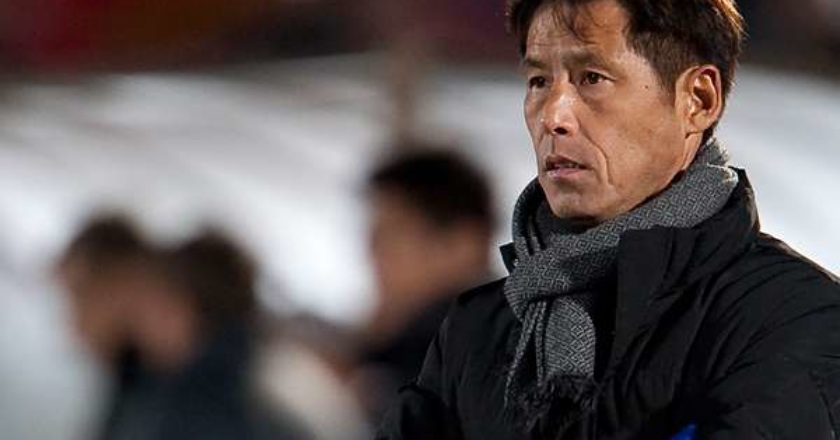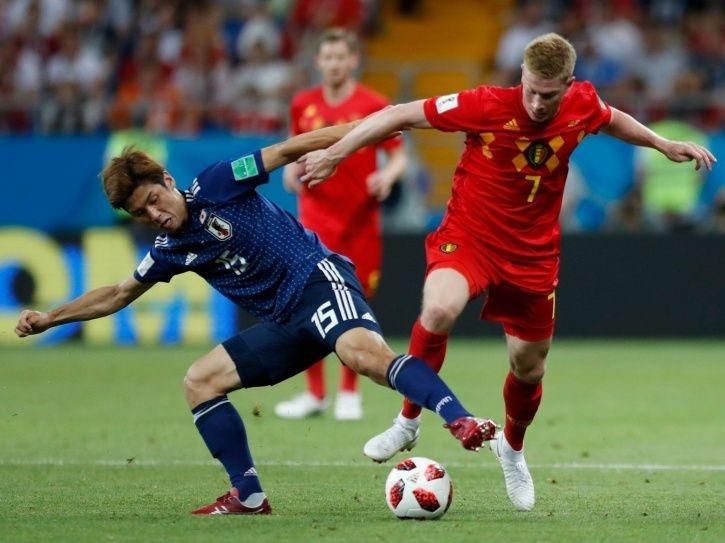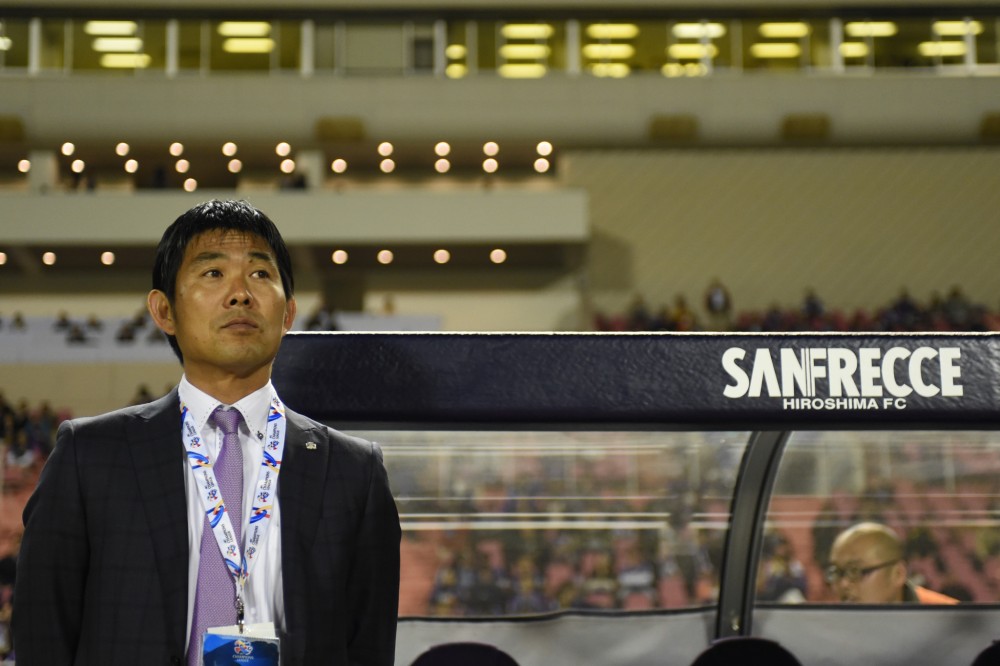It is the 92nd minute in Rostov as Keisuke Honda lines up to take a free kick. The ball is a comfortable 40 yards or so from goal and very few would dare to shoot at goal from that distance. Unknown to the Belgium & Chelsea shot-stopper in goal, Thibaut Courtois, those few individuals include… Keisuke Honda. With a short run-up, Honda strikes at goal. His knuckle-ball free-kick dips wickedly and Courtois scrambles away the ball in the last moment to prevent an embarrassment for Belgium.
Courtois then collects the ball from the ensuing Japanese corner and launches a deadly counter. The counter proves fatal for Japan as most of the blue samurai are caught high up the pitch. After a terrific run and incisive pass by De Bruyne, Thomas Meunier hits a low ball across the goal from the right flank. Romelu Lukaku then cleverly lets the ball run through his legs to super-sub Nacer Chadli in front of a wide-open net. Despite a valiant dive from the Japanese goalkeeper Kawashima, Chadli makes no mistake to put Belgium ahead 3-2 on the night. A few moments later, the referee blows his whistle to call time on arguably the best match of World Cup 2018 and what will surely go down as an all-time world cup classic. None of this matters to the Japanese team who appear shocked and in despair.
Yet, strangely enough, there is a feeling of joy among the fans of the beautiful game, world over. They had just witnessed 90 minutes of end to end attacking football in a world cup knock-out game. This game was a representation of football at its finest; a match played in the true spirit of the game with none of the dull, defensive, bad-blood filled cynical gameplay that has engulfed the game in modern times. Japan for one, may look back at this game as a missed opportunity. At the same time, they can be proud of the fact that they went toe to toe with Belgium’s golden generation; a team that has world class stars in literally every position on the pitch and then some more.
The implications of this match and Japan’s performances in Russia could have far reaching effects on the future of Japanese football…
Japan’s Run in to The World Cup
Not much was expected of Japan going in to this world cup. Japan had gone through a fairly turbulent world cup qualifying campaign with coach Halilhodzic never really sure of his starting eleven. To make matters worse, many of the established Europe-based stars were often dropped, especially the ‘Big 3 of Japanese Football’ (Kagawa, Okazaki and Honda). While it is true that these stars are ageing and not what they used to be, it is safe to assume that they are still a cut above much of the young talent coming through. Halilhodzic certainly had the right intentions with using fresh talent but his approach was far too chaotic and rubbed many the wrong way, not least the Japan Football Association (JFA). Unsurprisingly, Halilhodzic was fired 2 months before the World Cup.
While this certainly created a problem for Japan and might have rendered their world cup preparations moot, it appeared to be the right call. Many of the team’s players had felt alienated and there certainly seemed to be more to the issue then a string of bad results. So, the JFA made a very bold call by appointing Akira Nishino.

With less than two months to go before the World Cup, Nishino’s task appeared a herculean one. However, that said, Nishino is a coach with vast experience in the J-league. The first move he made was to recall all the Europe based stars. His final 23-man squad for the World Cup included very few players from the J-League. His reasoning was that Japan needs players who can perform in the big moments and not freeze up.
Nishino just had three games to get his team ready and firing for the world cup with friendlies lined up against Switzerland, Ghana and Paraguay. Japan’s games against Switzerland and Ghana ended in defeat but their play appeared to be strong and attack-minded. They did eventually manage to beat Paraguay 4-2 in their most encouraging performance in some time.
So, the stage was set for a very interesting world cup that no one had given Japan any chance so far. Japan were in for a stern test against Colombia in their first game.
Japan Surprises All
Jose Pekerman’s Colombia entered this World Cup looking to better their quarter final finish in Brazil 4 years ago. With Radamel Falcao finally back to spearhead the attack, it looked like Colombia were ready to announce their arrival on the big stage in style. Add to that, a star-studded team with the likes of James Rodriguez, Juan Cuadrado, Carlos Bacca, Yerry Mina and Juan Fernando Quintero, it looked like Colombia might even be a ready for a tilt at the World Cup. In life though, things rarely go according to plan.
Five minutes into their opener against Japan, Yuya Osako raced away on a counter and his shot on goal was blocked by David Ospina. Shinji Kagawa followed up on the rebound and his goal bound shot was blocked by Carlos Sanchez’s outstretched hand. The referee didn’t hesitate to point to the spot and send Sanchez off. Kagawa calmly tucked away the following penalty to give Japan the lead. While Colombia did equalise through Quintero, their man disadvantage rendered their attack toothless. Colombia had shifted into a defensive mindset and it started to tell on their stamina as the game wore on. Japan would eventually get the winner after super-sub Keisuke Honda’s corner was headed in by Osako. It was a lead Japan would never relinquish and claim their (and Asia’s) first ever victory over South American opposition at the World Cup.
Japan’s second game against Senegal would turn out to be another see-saw game with each side periodically trading blows over 90 minutes. The match would finish 2-2 with substitute Honda once again doing the damage with a second half equaliser. With Japan needing just a draw in their final group game against Poland, Japan fielded an experimental line up. Coach Nishino made 6 changes to the team that had played against Senegal. The move however backfired and Japan lost 1-0 to the already eliminated Poland. Yet as fate would have it, Japan would still progress to the round of 16 despite being tied on the same points, goals scored and goal difference with Senegal. In another first, Japan would become the first team to progress to the knock out rounds on the basis of a better disciplinary record.
The dream knock out fixture with Belgium was set as history beckoned for the men from the land of the rising sun.
Japan vs Belgium – A Match for The Ages

Belgium were widely expected to win this game comfortably after their stellar group stage performances and the fact they were tipped as World Cup contenders. What panned out though had Belgium in shock for a good portion of the game and turned into an absolute roller coaster of a game.
Although Belgium generally looked dominant in the first half, Japan were organized defensively and looked to attack on every opportunity they could get, throwing numbers forward in attack. Additionally, Japan looked very composed in possession when they had the ball. When the whistle blew for half time, it appeared as though it would be a matter of time before Belgium took total control over proceedings. Japan clearly had other ideas.
The blue samurai raced into a two-goal lead within the first ten minutes of the restart through Genki Haraguchi and Takashi Inui (who was having a stellar World Cup). All of a sudden, it seemed as though Belgium were staring at a shock exit. Credit must however go to Belgium’s gaffer Roberto Martinez for recognising Japan’s age-old issue with physical play. Off went the speed and silky dribbling skills of Carrasco and Mertens and on came the physically imposing Fellaini and Chadli. In an all too familiar turn of events, Belgium started bombarding the penalty area with dangerous crosses. The pressure soon told and Belgium were soon level through a freak header from Vertonghen and a powerful point-blank header from Fellaini. It was here that perhaps Akira Nishino made his only mistake as Japan’s coach in the world cup. There appeared to be a hesitation on his part to bring on fresh legs and perhaps he waited a little too long to bring on Keisuke Honda.
The roller coaster nature of this game still served up enough chances for Japan as well as Belgium to win it. The fatal blow for Japan eventually arrived in the most cruel fashion in the 93rd minute and Chadli made no mistake to put Belgium through to the quarter finals. Many, including Fabio Capello felt that Japan were perhaps a bit too naive after taking a two-goal lead and should have been more cynical. While there is certainly an element of truth to that, the game could so easily have ended differently. Such are the fine margins of sport at this level.
The Positives & The Japanese Way
Russia 2018 was the third time in history that Japan had made it to the Round of 16 at the World Cup and got knocked out, just the same. Something definitely felt markedly different this time around though. When Japan’s golden generation made the cut in 2002, their performances were solid and it was on home soil. Granted, Japan won two games in the group stage but Troussier’s approach to the game was more conservative. The very fact that he dropped future national team legend Shunsuke Nakamura and regularly deployed the defensive minded Myojin and Toda serve to highlight this.
When Japan repeated the feat in 2010 in South Africa, the brand of football was once again defensive. Although Japanese football had progressed significantly enough since 2002, Takeshi Okada’s inability to coax the best out of the team’s talents, led to him reverting to his trademark defensive style. Even though Japan performed well in South Africa, a huge portion of the credit must go to arguably their best ever central defensive pairing of Yuji ‘Bomberhead’ Nakazawa and Marcus Tulio Tanaka (Japan’s version of Beckenbauer). This was probably the only time in their history that Japan didn’t look susceptible to crosses.
Fast-forward to 2018 and it appears as though Japan have finally embraced their true identity. For the first time in all their world cups, Japan played with the fast-passing, team work and flair that has come to characterise their play over the years. All too often, Japan have fallen apart on the big stage. Coach Nishino clearly recognised Japan’s short comings from previous World Cups and picked a team that knew how to handle the pressure on the big stage. At no point did Japan appear fazed or mentally rattled. This was particularly highlighted in the game against Senegal when Japan twice came back from behind to level the scores. Throughout Nishino’s coaching career, he has always chosen to go all out when the odds were stacked against him. Gamba Osaka’s 3-5 loss to Manchester United in the FIFA Club World Cup several years is a case in point. So, what then of individual performances?
Individuals Matter
Unsurprisingly, a good chunk of Japan’s best play came from its top-class midfielders. Veteran super stars Shinji Kagawa and Keisuke Honda showed they still had something left in the tank and were decisive in Japan’s most crucial moments. Captain Makoto Hasebe had a fine world cup in central midfield and kept the team’s shape and balance. However, it is fair to say that he was outshone by his central mid-field partner Gaku Shibasaki. Shibasaki has quietly become one of Japan’s best players in the last few years. He first came under the spotlight when his 2-goal performance for Kashima Antlers against Real Madrid nearly pushed the Galacticos to the brink in the FIFA Club World Cup final. He then moved to Tenerife in the Spanish Segunda where his great performances earned him a move to Getafe. Shibasaki had a terrific world cup with his energetic all round displays and ability to dictate the game from deep.
Above all these performances though, the biggest surprise came from wide midfielder cum winger Takashi Inui. He was arguably Japan’s star performer and his pace & ability to cut in from the left flank caused opposition defences no end of problems. He was justly rewarded with 2 terrific goals for his efforts. The most surprising part is that at 30 years of old, Inui is no spring chicken or the latest find. Strangely, in this last decade of ‘Kagawa-Honda-Okazaki’ dominance, Inui has largely been ignored for national team duties. He has quietly made a name for himself in Europe with strong performances in Germany and then with La Liga surprise package Eibar. It is only fitting that high flying Real Betis have signed the tricky winger.
Other noteworthy performances also came from the likes of Fortuna Dusseldorf winger Genki Haraguchi with his tireless running; and from the evergreen Yuto Nagatomo. The long-time Inter Milan and current Galatasaray left wing back provides such a 2-way presence on the flanks that he can never be ignored. It is hard to imagine Japan getting this far without his lung bursting forays into the attacking third. Hiroki Sakai also ran himself into the ground on the right side of defense.
So where does Japan go from here?
The Future Looks Bright
With Honda, Hasebe and Gotoku Sakai all announcing their retirement after the World Cup, it looks as though Japan is set for an exciting new era. It is expected that the likes of Kagawa, Maya Yoshida and Okazaki will be eased out over the coming years. The time has come for the likes of Shibasaki and the highly promising Gen Shoji to don the mantle and take Japan forward. Players like Takashi Usami, Takuma Asano and Shoya Nakajima could have very important roles to play over the next few years.

The announcement of former Sanfrecce Hiroshima and current Japanese Olympic team manager Hajime Moriyasu as the new national team coach is a step in the right direction. It is an indication that Japan has well and truly started embracing their true identity; perhaps a sign that all answers lie within and not externally.
Could the sun finally be rising over the land of cherry blossoms? Exciting times lie ahead…

You must be logged in to post a comment.